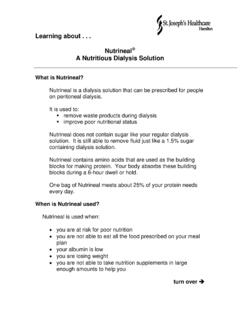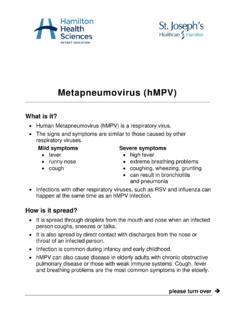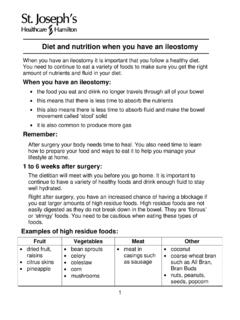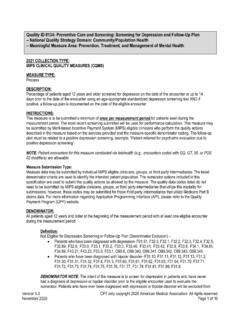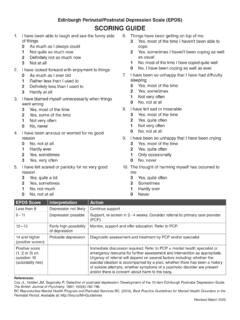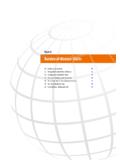Transcription of Identifying and Treating Postpartum Depression
1 264 JOGNNV olume 34, Number 2 CLINICAL ISSUESI dentifying and Treating Postpartum DepressionJune Andrews Horowitz and Janice H. GoodmanPostpartum Depression affects 10% to 20% ofwomen in the United States and negatively influencesmaternal, infant, and family health. Assessment of riskfactors and Depression symptoms is needed to identi-fy women at risk for Postpartum Depression for earlyreferral and treatment. Individual and group psy-chotherapy have demonstrated efficacy as treatments,and some complementary/alternative therapies showpromise. Treatment considerations include severity ofdepression, whether a mother is breastfeeding, andmother s preference. Nurses who work with childbear-ing women can advise depressed mothers regardingtreatment options, make appropriate recommenda-tions, provide timely and accessible referrals, andencourage engagement in treatment. JOGNN, 34,264 273; 2005. DOI: :Mental health Postpartum depres-sion Psychiatric referral Psychopharmacology PsychotherapyAccepted: September 2004 Postpartum Depression (PPD) is a serious andcommon mood disorder that emerges within severalweeks after delivery and poses significant risks tomaternal, infant, and family well-being.
2 Onset ofdepression during this critical time interferes withmothers ability to recognize and respond to theirinfants cues in a sensitive way and thwarts theevolving maternal-infant relationship (C. T. Beck,1996). When PPD is undetected or inadequatelytreated, a chronic depressive course can result withpotential negative outcomes for the entire family(Campbell & Cohn, 1997; Horowitz & Goodman,2004).Despite adverse health consequences, systematicPPD screening is not standard clinical practice in theUnited States. Limited availability of psychiatricservices impedes referral for evaluation and treat-ment. Nurses require knowledge about the natureand efficacy of PPD treatments to refer their clientsand recommend psychiatric services with confi-dence. To inform nursing practice, this articledescribes PPD, examines screening approaches, andsynthesizes the literature concerning evidence-basedtreatments for of Postpartum DepressionDescription, Prevalence, and CourseSymptoms that typically characterize PPD includedespair, sadness, anxiety, fears, compulsive thoughts,feelings of inadequacy, loss of libido, fatigue, anddependency (Sichel, 2000).
3 A diagnosis of PPDrequires a major depressive episode with onset dur-ing the first 4 weeks after delivery (American Psy-chiatric Association, 2000); however, researcherscommonly define Depression occurring within 3months Postpartum as PPD (Wisner, Parry, & Pio-ntek, 2002). According to psychiatric diagnostic cri-teria (American Psychiatric Association, 2000), theessential feature of a major depressive episode is a 2-week or longer period during which a woman haseither depressed mood or loss of interest or pleasurein activities that is a change from previous function-ing. Presence of four or more of the additional symp-toms nearly every day also is required for a diagno-sis: significant weight loss when not dieting orweight gain or change in appetite, insomnia orhypersomnia, psychomotor agitation or retardation,March/April 2005 JOGNN265fatigue or loss of energy, feeling guilty or worthless,decreased ability to think or concentrate, and recurrentthoughts of death or suicide with or without a plan(American Psychiatric Association, 2000).
4 If depressedmood and loss of interest and pleasure in activities arepresent, only three of the additional symptoms are need-ed. When anxiety, agitation, and disturbing thoughtsdominate the presentation, Sichel and Driscoll (2000) havedescribed this symptom cluster as Postpartum obsessive-compulsive disorder, although many clinicians considerthis a variant of Postpartum women, symptoms must be evaluatedin relation to anticipated changes and infant caredemands. For example, weight loss associated with nor-mal Postpartum recovery and sleep problems caused byinfant sleep patterns should not be considered as depres-sive affects approximately 500,000 mothers andinfants in the United States each year (Wisner et al.,2002). Approximately half of affected women in the Unit-ed States receive no mental health evaluation or treatment(Hearn et al., 1998). One meta-analysis determined over-all PPD prevalence to be 13% ( , 1 in 8 women; O Hara& Swain, 1996), and estimates of moderate to severe PPDin the United States range from 8% to 12% (Merritt,Kuppin, & Wolper, 2001; Najman, Anderson, Bor,O Callaghan, & Williams, 2000).
5 For many women, PPD remits between 2 and 3 monthspostpartum (Beeghly et al., 2002; Horowitz et al., 2001);however, Depression may continue through the 1st and2nd Postpartum years (Josefsson, Berg, Nordin, & Syd-sjo, 2001). Horowitz and Goodman (2004) found that at2 years after delivery, of participants who previ-ously exhibited PPD symptoms within a month afterdelivery continued to score in the depressed range on theBeck Depression Inventory II (A. T. Beck, Steer, & Brown,1996). Such research results show that PPD can evolveinto an ongoing course of Depression throughout the first1 to 2 years after of PPD on the FamilyPPD threatens the quality of family health. Multiplestudies have linked PPD with maternal behavior that isless affectionate and more withdrawn, or intrusive andhostile, and infant behavior that is avoidant, discontent,and withdrawn (Dawson & Ashman, 2000; Tronick &Weinberg, 1997).
6 C. T. Beck (1995) demonstrated thatPPD had a moderate to large effect on maternal interac-tive behavior, infant interactive behavior, and dyadicinteractive behavior. In a subsequent meta-analysis, C. (1999) found a moderate relationship betweenmaternal Depression and behavioral problems of childrenfrom 1 to 18 years of age. Evidence is also accumulatingthat PPD has negative influences on fathers mentalhealth, suggesting that a family perspective on assessmentand treatment is needed (Goodman, 2004). Identifying Women at Risk for Postpartum DepressionIdentifying women who may be at increased risk forPPD is an important clinical goal. Despite growingknowledge that PPD is a major childbirth complication, Postpartum Depression screening is not yet standard carein the United States (Georgiopoulis et al., 1999; Horowitzet al., 2001).Risk Assessment During PregnancyPrenatal assessment for PPD risk is an impreciseendeavor.
7 At present, no reliable, valid, prenatal screeninginstrument is available for routine use (Austin & Lumley,2003), but use of assessment measures and clinical inter-viewing may detect known prenatal risk factors anddepressive symptoms. Therefore, a two-prongedapproach to identify pregnant women at risk for PPD isneeded: identification of PPD risk factors in the healthhistory and current psychosocial situation and depressionsymptom range of risk factors has been associated with PPD,and research results have been contradictory in manyinstances; however, a few characteristics have emergedthat are likely to raise PPD risk. Prenatal Depression oranxiety, history of Depression , inadequate social support,poor quality of the relationship with a partner, and lifeand child care stress have been the most consistentforecasters of PPD. Low socioeconomic status and diffi-cult infant temperament have been inconsistent andweaker predictors (C.)
8 T. Beck, 2001; Nielson, Videbech,Hedegaard, Dalby, & Secher, 2000). C. T. Beck s (2001)most recent meta-analysis uncovered four new predic-tors: low self-esteem, unpartnered marital status, lowsocioeconomic status, and unplanned/unwanted mothers may have increased PPD likeli-hood (Hudson, Elek, & Campbell-Grossman, 2000), butotherwise, maternal age does not tend to increase is another inconsistent predictor. Researchers typi-cally have not found an association between parity andPPD affects a half-million mothers in theUnited States each year, and approximatelyhalf of these women receive no mentalhealth evaluation or 34, Number 2 PPD (G rel & G rel, 2000). Ethnicity and race typicallyare not significant PPD predictors (Yonkers et al., 2001).Biologic studies have produced little conclusive data,although the effects of rapid alteration in hormonal levelson the neuroendocrine system remain poorly susceptibility possibly affects reactions ofmonoamine and peptide pathways to Postpartum hor-monal fluctuations (Sichel, 2000).
9 Thus, given the available research evidence, the fol-lowing factors merit prenatal PPD risk evaluation: histo-ry of Depression or anxiety disorder, presence of prenataldepression or anxiety symptoms (including previousPPD), inadequate social or partner support, and situa-tional and parenting stress. In addition, monitoring veryyoung or poor pregnant women is appropriate becausethey may have increased PPD health history and psychosocial assessmentin pregnancy, with periodic updates to identify anychanges in situational factors, may identify women whohave increased PPD risk. Providing anticipatory guidanceabout PPD risk factors, prevalence, and typical symptomscould alert women who have one or more risk factors tothe importance of contacting their health care providerswhenever Depression or anxiety symptoms persist beyond2 weeks Postpartum . Clearly, clinicians interviewingskills and clinical judgment are critical elements in identi-fying and monitoring PPD risk factors.
10 However, assess-ment tools are available to identify known prenatal PPDrisk factors or evaluate Depression symptom Depression Screening and Symptom MeasurementThe Cooper Survey (Cooper, Murray, Hooper, & West,1996) was developed as a predictive index for PPD. Theinstrument developers tested the measure with 6,000pregnant women. Based on responses of two thirds of thesample, the original items were reduced to produce a pre-dictive 17-item index that was applied to the remainingthird of the sample for validation. The index predictedthat 35% of pregnant women who scored 27 or higherwere later found to have PPD, a higher percentage thanthe approximately 10% to 15% that generally could beexpected without prenatal risk identification. The toolhas been an effective prenatal measure of PPD risk(Honey, Bennett, & Morgan, 2003).Because Postpartum factors such as maternity bluesand parenting stress add to PPD risk, this instrument sability to identify pregnant women at increased risk isnoteworthy.

